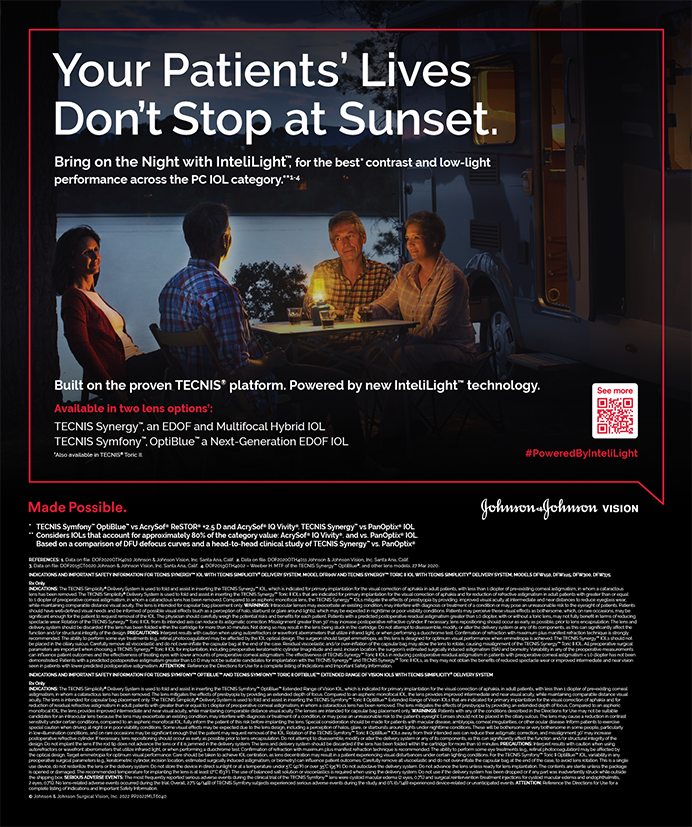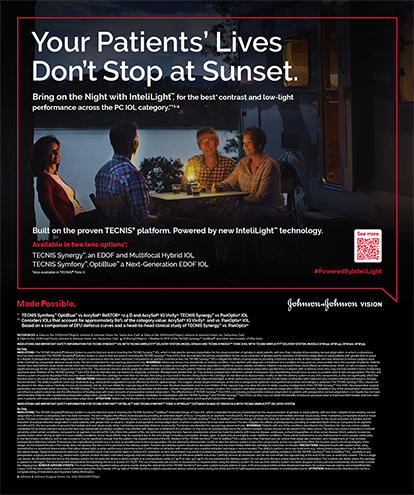The pursuit of flawless surgical outcomes fuels the persistent evolution of cataract surgery. Beginning with the development of phacoemulsification by Charles D. Kelman, MD, continuing advances promise better postoperative results. Phaco machines have expanded margins of safety, and lens designs produce superior visual outcomes. These advances may not equate with improved surgical results, however, if the surgical technique itself is compromised.
Arguably the most important and most difficult step in cataract surgery, the capsulorhexis is critical to the safety and efficacy of the procedure.1,2 A good anterior capsulorhexis is centered and circular, and it has a clean, undamaged capsular edge. Surgeons use a manual technique with either a bent needle or forceps to create the capsulorhexis. Now, early results with a new generation of femtosecond lasers for intraocular use show promise for the creation of the anterior capsulotomy as well as for nuclear fragmentation and incisional architecture. Many questions require answers. Will this generation of femtosecond lasers pave the way for enhanced outcomes in refractive cataract surgery? Will it reduce the risk of adverse events, including endophthalmitis, posterior capsular rupture, endothelial cell loss, zonular dehiscence, macular edema, and retinal detachment?
Femtosecond-delivered laser pulses to the anterior capsule and crystalline lens during cataract surgery require different parameters than those used by femtosecond lasers for corneal surgery. More specifically, intraocular femtosecond lasers penetrate deeper into the eye—approximately 7,500 μm versus 1,200 µm in corneal surgery.3 Three companies are developing femtosecond laser cataract surgery technology: LensAR, Inc. (Winter Park, FL), LenSx Lasers, Inc. (Aliso Viejo, CA), and Optimedica Corporation (Santa Clara, CA). These companies are banking on the idea that femtosecond lasers will improve the precision of key surgical steps and translate into maximal postoperative outcomes.
In time, surgeons will be able to evaluate femtosecond cataract technologies and determine if they are worth the investment. Until then, ophthalmologists rely on commentary from the companies and the key opinion leaders who have already tested these technologies. All three companies mentioned herein have a unique position in the current marketplace. This article provides an overview of all three femtosecond cataract laser systems and recaps previously released and published clinical results.
LENSAR
This platform is now in development for constructing the anterior capsulotomy, fragmenting the nucleus, and creating limbal relaxing and clear corneal incisions (Figures 1 and 2) Company information alludes to a different initial direction for its femtosecond laser—presbyopic correction. Randy W. Frey, the CEO of LensAR, Inc., licensed a patent and patent application to use the technology for softening the natural crystalline lens to restore accommodation. Studies with the prototypic laser quantified a strong safety profile for presbyopic correction and showed that it avoided cataract formation in a sensitive animal model, according to company information.
After some prompting from the LensAR, Inc., board member Richard Keates, MD, Mr. Frey decided to turn his attention to cataract surgery. In the first cataract procedures, the laser accomplished perfect capsulotomies and aspiration of lens material sans phaco ultrasound power. Ramon Naranjo Tackman, MD, director of Corneal Services at APEC Hospital Luis Sanchez in Mexico City, is among the surgeons with clinical experience using the LensAR laser for cataract surgery. According to the company, Dr. Naranjo Tackman has used the laser to cleanly cut cataracts of up to grade 4. After a recent algorithm upgrade, Harvey Uy, MD, from Manilla, Philippines, has laser fragmented and removed cataracts with significantly reduced ultrasound energy as hard as grade 5, Mr. Frey told Cataract & Refractive Surgery Today in an e-mail. “The detailed algorithms really matter on the higher grade cataracts,” Mr. Frey said.
The LensAR Laser System offers measurement-guided beam delivery for automated measurements and for cutting ocular anatomy using proprietary, modified Scheimpflug imaging. According to the company, results with this technology were accurate in animal studies and confirmed in human clinical studies. The company continues to research LensAR’s applications for cataract surgery.
Mr. Frey said that the company is near approval on the first indication for anterior capsulotomy with the laser. “We are working the trials for nuclear lens fragmentation now and that will be the next 510(k) approval sought. We would then seek approval on the cataract incision—clear corneal incision—and limbal relaxing incisions (astigmatic) as well.” Upon FDA approval, a software upgrade will be available for presbyopic algorithms.
LENSX
Image-guided clinical applications of the LensX Laser include liquefying, softening, or fragmenting the lens; forming the anterior capsulotomy; and creating all corneal incisions (Figures 3 and 4). Company literature explains that integration of proprietary optical coherence tomography allows precise localization of surgical laser pulses.
Zoltan Nagy, MD, professor at Semmelweis University in Budapest, Hungary, was the first to use the LenSx technology clinically.4,5 In his study, the laser was used for anterior capsulotomy in 60 cases; all capsulotomies had smooth, uniform edges, and there were no capsular tears or adverse events. Dr. Nagy compared these results with those for 60 control individuals in whom manual capsulotomy was performed. The diameter of the capsulotomies created with the LenSx was significantly more reproducible. Dr. Nagy reported that the diameter of the capsulorhexis was individualized for each treatment, with the diameter of his typical capsulotomy ranging from 4.5 to 5.0 mm for a 6.0-mm optic. According to ex vivo testing and scanning electron microscopy in animal models, similar smoothness and mechanical strength of the capsulotomies were seen with the femtosecond laser and manual capsulotomy.
The LenSx Laser is also being evaluated for lens fragmentation. In Dr. Nagy’s initial series, softer lenses were successfully fragmented into small pieces that were removed with I/A and required no phacoemulsification. Harder lenses were successfully fragmented into quadrants for more efficient removal with low phaco power and energy. He reported no complications and, in an earlier article in CRSToday Europe, said that the technology “eliminates the need for manually creating grooves with the phacoemulsification handpiece.”6 Furthermore, less total ultrasound power was used compared with other phaco techniques.
LenSx Lasers, Inc., has established a second clinical site in Houston, where Stephen Slade, MD, performed the first femtosecond laser cataract surgery procedures in the United States in February.
Ronald Kurtz, MD; Tibor Juhasz, PhD; and Eric Weinberg are the cofounders of LenSx Lasers, Inc. The LenSx Laser is currently the only femtosecond laser to receive 510(k) clearance by the FDA for the creation of anterior capsulotomies and corneal incisions.
OPTIMEDICA
With an outstanding reputation in the field of retinal surgery and retinal lasers, Optimedica Corporation recently extended its reach to cataract surgery. Behind the scenes, the company worked to develop a noninvasive, intraocular femtosecond technique for some of the most techniquedriven steps of cataract surgery. Company literature reports that this laser is capable of creating precise corneal incisions and capsulorhexes and of fragmenting the lens (Figures 5 through 7).
Safety studies are complete, with ongoing clinical trials reportedly showing promising results. According to the company, its femtosecond laser is en route to providing significant benefits to both surgeons performing and patients undergoing the cataract procedure. Ongoing trials will provide optimized treatment algorithms, according to company literature.
A cataract surgical video featuring Optimedica Corporation’s femtosecond laser was shown at the 2009 AAO Annual Meeting in San Francisco. The technology uses real-time intraoperative optical coherence tomography visualization in the anterior chamber and on the cornea to determine the relevant dimensions and thicknesses of the lens and cornea and to guide treatment.
DIFFERENTIATION OF PLATFORMS
In an interview with CRSToday, John Vukich, MD, said how the three companies will differentiate their lasers remains to be seen.
“All three of the platforms use similar concepts and view the market similarly in terms of the platform’s appeal,” he said. “It will come down to the delivery of the unit, including such things as are the ergonomics consistent with OR flow? Is it easy to use? Is the interface friendly for the surgeon? Does it provide a rapid turnaround?” Dr. Vukich is a partner at the Davis Duehr Dean Center for Refractive Surgery in Madison, Wisconsin, and is a consultant to and investigator for Optimedica Corporation. He said that the technology has to be efficient and smooth; it has to be a platform that is easy to use.
PERFECT TIMING
“It has been a decade or more since there has been real innovation in cataract surgery,” said William J. Link, PhD, in an interview with CRSToday. “The femtosecond laser technology advanced LASIK surgery nicely, and it provided ideas about how it could be developed for use in cataract surgery.” Dr. Link is the founder and managing director of Versant Ventures, a leading health care-focused venture capital firm specializing in early-stage investments in medical devices, biotechnology and pharmaceuticals, health care services, and health care information technology. The firm is located in Menlo Park, California.
“I am optimistic that femtosecond technology will penetrate the cataract market substantially,” Dr. Link said. “The initial customers will be surgeons who are implanting premium IOLs for presbyopia as well as performing cataract removal. Experts believe that the femtosecond laser will deliver some services in the cataract procedure that are currently uncovered and could demand premium pricing.”
Although the early adopters will be cataract practices and surgeons already in the premium channel, Dr. Link predicts that, as the technology is refined and used more broadly, it will penetrate into standard cataract procedures.
“Ophthalmic surgeons are wonderful customers for new technology, because they are familiar with laser technology,” he said. “This will be a refreshing opportunity for surgeons to use those skills in the cataract procedure. I think it's a natural fit.”
Regarding the appeal of femtosecond cataract technology to patients, Dr. Link said they have always wanted to believe surgeons were doing laser cataract surgery. So there is an openness on the part of consumers that laser surgery is better than traditional surgery.
“This is a natural and important evolution in cataract surgery,” Dr. Link remarked. “This is the way innovation can work, where technology is developed and refined in one application—in this case LASIK—and then it is refocused and redeployed in another application. The timing is perfect for cataract sugery to advance to the next level.”
CONCLUSION
The latent potential of intraocular femtosecond lasers is surfacing, with growing support from the industry to develop this technology for prime-time use. If surgical results with the femtosecond laser continue to improve the precision, reproducibility, and predictability of cataract surgery (including lens fragmentation, the incision’s creation, and the capsulorhexis), it may be wise for ophthalmologists to consider investing in an intraocular femtosecond laser. The next few years will be telling.
- Dooley IJ,O’Brien PD.Subjective difficulty of each stage of phacoemulsification cataract surgery performed by basic surgical trainees.J Cataract Refract Surg. 2006;32:604-608.
- Oetting TA,Lee AG,Beaver HA,et al.Teaching and assessing surgical competency in ophthalmology training programs. Ophthalmic Surg Lasers Imaging. 2006;37:384-393.
- Phend C.AAO:femtosecond lasers promising for safer cataract surgery.Medpage Today Web site. www.medpagetoday.com/tbprint.cfm?tbid=16706.Accessed March 12,2010.
- Nagy Z.Use of femtosecond laser system in cataract surgery.Paper presented at:XXVII Congress of the ESCRS;September 15, 2009;Barcelona,Spain.
- Nagy Z,Takacs A,Filkorn T,Sarayba M.Initial clinical evaluation of an intraocular femtosecond laser in cataract surgery.J Refract Surg. 2009;25(12):1053-1060.
- Nagy Z.Intraocular femtosecond laser applications in cataract surgery.Cataract & Refractive Surgery Today Europe. 2009;4(8):29-30.


